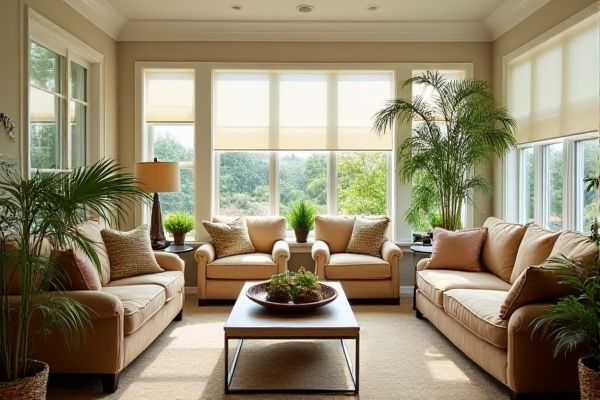
UV-blocking film significantly reduces harmful ultraviolet rays, protecting your furniture and skin from sun damage while maintaining clear views in your sunroom. Explore the differences between UV-blocking film and solar shades to determine which option best suits your home's needs and comfort.
Table of Comparison
| Feature | UV-Blocking Film | Solar Shades Sunroom |
|---|---|---|
| Primary Function | Blocks up to 99% of harmful UV rays | Reduces heat and glare with adjustable shading |
| Installation | Applied directly to window glass | Mounted on window frames or ceiling |
| Light Control | Maintains natural light, reduces UV only | Blocks sunlight partially or fully, adjustable |
| Heat Reduction | Moderate heat rejection (up to 40%) | Higher heat rejection (50-70%) depending on fabric |
| Cost | Lower upfront cost, professional installation | Higher cost, DIY or professional installation |
| Durability | Long-lasting, 10+ years with proper care | Durable fabric shades, 5-10 years depending on exposure |
| Aesthetics | Invisible, preserves window appearance | Visible shades, variety of styles and colors |
| Maintenance | Minimal cleaning needed | Regular cleaning required to prevent fabric wear |
Introduction to Sunroom Sun Protection
Sunroom sun protection enhances comfort and preserves interior furnishings by reducing harmful UV rays and solar heat gain. UV-blocking film effectively filters up to 99% of ultraviolet radiation, preventing fading and skin damage. Solar shades complement sunroom environments by providing adjustable light control and reducing glare while maintaining outdoor views.
What Is UV-Blocking Film?
UV-blocking film is a transparent, adhesive layer applied to sunroom windows that filters out harmful ultraviolet rays, reducing glare and protecting interior furnishings from fading. Unlike solar shades, which physically block sunlight, UV-blocking film maintains natural light flow while enhancing energy efficiency and heat reduction. This film technology often provides up to 99% UV ray rejection, making it a durable and low-maintenance solution for sunroom sun protection.
What Are Solar Shades?
Solar shades are specially designed window treatments that reduce heat and glare by blocking ultraviolet (UV) rays while still allowing natural light to enter a sunroom. These shades use tightly woven fabrics with varying openness factors to control light filtration and improve energy efficiency. Unlike UV-blocking film that adheres directly to glass, solar shades offer adjustable coverage and can complement a sunroom's decor while providing UV protection.
UV Protection Comparison: Film vs. Shades
UV-blocking films offer up to 99% ultraviolet protection by filtering harmful rays before they enter the sunroom, reducing skin damage and fading of furniture. Solar shades typically block 90-95% of UV radiation while allowing some natural light and visibility, balancing comfort and protection. Installing UV-blocking film provides a more permanent and comprehensive barrier against UV exposure compared to the adjustable, light-filtering properties of solar shades.
Heat Reduction: Which Option Performs Better?
UV-blocking films typically reduce heat by blocking up to 99% of harmful ultraviolet rays, significantly lowering interior temperatures and preventing sun damage. Solar shades, however, excel in heat reduction by reflecting and absorbing solar energy before it enters the sunroom, often providing superior thermal comfort with varying openness factors to balance light and heat control. For optimal heat reduction in sunrooms, solar shades generally outperform UV-blocking films due to their targeted solar energy management and customizable light filtration.
Privacy and Light Control Differences
UV-blocking film provides effective protection against harmful ultraviolet rays while maintaining a clear view, allowing natural light to flow into the sunroom without significantly altering visibility. Solar shades offer variable light control through adjustable opacity levels, enhancing privacy by limiting visibility from outside while still reducing glare and heat. Solar shades typically provide superior privacy compared to UV-blocking film, which primarily focuses on UV protection without significantly obstructing sight lines.
Installation Process: UV Film vs. Solar Shades
UV-blocking film installs directly onto sunroom glass using adhesive layers, providing a seamless and nearly invisible barrier against harmful ultraviolet rays, with minimal tools required for application. Solar shades involve mounting roller mechanisms on window frames or ceilings, allowing adjustable light control but requiring precise measurements and hardware installation for proper alignment. Both methods effectively reduce UV exposure, but UV film offers a permanent solution while solar shades provide flexible shading options adaptable to changing sunlight conditions.
Maintenance and Durability Factors
UV-blocking films offer enhanced durability with scratch-resistant coatings and typically require only occasional cleaning using mild soapy water, ensuring long-lasting performance against sun damage. Solar shades for sunrooms, made from woven fabrics or mesh materials, demand careful maintenance to avoid fraying or fading and may require periodic replacement depending on exposure to harsh weather conditions. Both solutions resist UV rays effectively, but UV-blocking films generally provide a more permanent, low-maintenance option compared to the fabric-based solar shades that experience wear and tear more readily.
Cost Analysis: Upfront and Long-Term
UV-blocking films for sunrooms generally have a lower upfront cost compared to solar shades, often ranging from $5 to $10 per square foot versus $15 to $30 per square foot for high-quality solar shades. Over the long term, UV-blocking films require minimal maintenance and can extend the lifespan of interior furnishings by reducing sun damage, while solar shades may need periodic replacement or repair due to wear and mechanical components. Energy efficiency gains from both options can lower cooling costs, but solar shades typically offer better overall control of light and heat, potentially delivering greater savings over time.
Choosing the Best Sunroom Solution for Your Needs
UV-blocking film offers an effective barrier against harmful ultraviolet rays, reducing sun damage to furniture and floors while maintaining clear views. Solar shades provide adjustable light control and enhanced privacy, allowing homeowners to regulate heat and glare with ease. Selecting the best sunroom solution depends on factors like desired light management, aesthetic preference, and energy efficiency goals.
 homyna.com
homyna.com